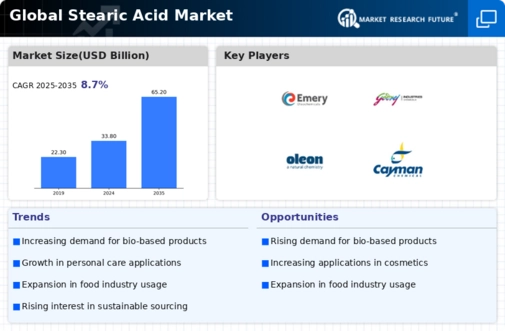Stearic Acid Market Summary
As per Market Research Future Analysis, the Global Stearic Acid Market is projected to grow from USD 33.8 Billion in 2024 to USD 50.80 Billion by 2032, at a CAGR of 8.70%. Stearic acid, a colorless waxy substance found in plant and animal fats, is widely utilized in personal care, soaps, detergents, agrochemicals, food products, pharmaceuticals, and textile sizing. The increasing demand for cosmetics and personal care products, driven by rising consumer spending, is a significant factor propelling market growth. Additionally, the textile sector in India and China, along with the automotive industry's growing use of stearic acid, further supports market expansion. However, some individuals with skin sensitivities may not tolerate stearic acid in cosmetics, as noted by the FDA.
Key Market Trends & Highlights
Key trends influencing the stearic acid market include rising demand across various industries and regional growth.
- The personal care industry is a major driver, with increased spending on cosmetics and skin care products.
- Asia Pacific is the fastest-growing market, fueled by rising disposable income and demand for personal care products.
- The automotive industry is increasingly utilizing stearic acid for its softening and dispersing properties.
- The pharmaceutical sector is expanding its use of stearic acid as an emulsifying and solubilizing agent.
Market Size & Forecast
| 2024 Market Size | USD 33.8 Billion |
| 2032 Market Size | USD 50.80 Billion |
| CAGR | 8.70% |
Major Players
Key players include Akzo Nobel N.V. (Netherlands), Wilmar International Ltd (Singapore), Croda International Plc (UK), Deeno Group (China), Emery Oleochemicals (Malaysia), Godrej Industries (India), Oleon (Belgium), Pacific Oleochemicals Sdn Bhd (Malaysia), Kaula Lumpur Kepong Berhad (Malaysia), Kao Corporation (Japan), Cayman Chemical (U.S.), Procter and Gamble (U.S.).















Leave a Comment